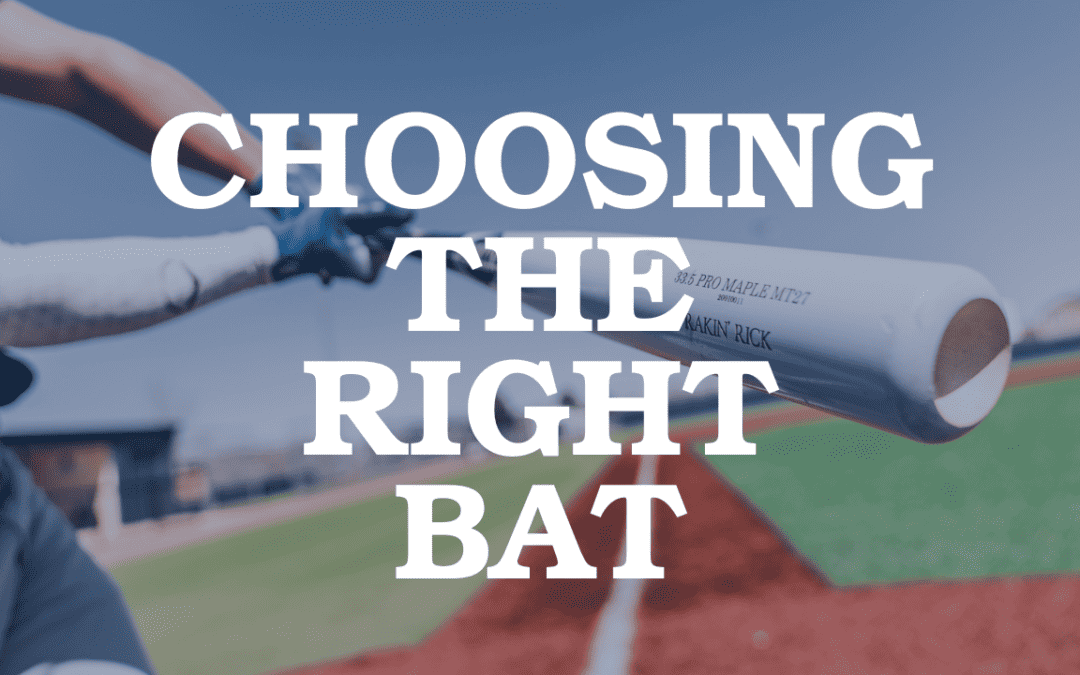Hitting with a wood baseball bat versus a metal baseball bat is a topic that has been debated for decades. Both types of bats have their own unique set of benefits and drawbacks, and the decision of which one to use ultimately comes down to personal preference and playing style.
One of the main benefits of using a wood baseball bat is that it is more traditional and has a more classic feel. Wood bats have also been shown to reduce the risk of injury to the pitcher and other players on the field by reducing the rebound speed of the ball. At Gameday, we like for our players to train with wood bats and use metal mats in games. Hitting with a wood baseball bat can be more beneficial for training for a few reasons. First, wood bats tend to have a smaller sweet spot compared to metal bats. This means that players have to be more precise with their swings and make better contact with the ball in order to hit it effectively. This can help players improve their swing and technique by forcing them to focus on making solid contact with the ball.
Additionally, wood bats are generally heavier than metal bats, which can help players build more strength and power in their swings. This can be especially beneficial for players who are looking to improve their overall hitting ability and generate more power.
Wood bats are less flexible and have a higher risk of breaking if the player makes contact with the ball in the wrong spot. This can help players learn to make better contact with the ball and avoid hitting it on the handle or the end of the bat. Furthermore, wood bats are more challenging to hit with at first, but once players are able to hit the ball well with a wood bat, it will be a lot easier to hit with metal bats. This is because wood bats have a smaller sweet spot and require more precision in the swing, which helps players to develop better hand-eye coordination, bat control and a better sense of timing.
On the other hand, metal baseball bats are generally considered to be more powerful and provide a larger hitting surface. This can be beneficial for players who are looking to hit the ball farther and generate more power. Metal bats are also typically more lightweight than wood bats, which can make them easier to handle and control. Another benefit of using a metal baseball bat is that it is less prone to breaking than a wood bat. Metal bats are made from aluminum alloy which is more durable than wood and can withstand more impact and pressure. This can be especially beneficial for players who are looking to improve their swing and technique, as they will not have to worry about constantly replacing a damaged bat. It should be noted that most youth/high school/college baseball players use metal bats, but training on a wood bat and using a wood bats in some select games is a suggested approach.
Professional players use wood bats and that’s due to how powerful their swings are and the danger a batted ball has to a players safety. There has even been a debate that older players in high school and college should be using wood bats for the very reason. However, even metal bats have been “weaken” a bit due to safety. BBCOR (Batted Ball Coefficient of Restitution) began in 2011 as an attempt to reduce the amount of “pop” or trampoline effect in non-wood bats, making them perform more like wood bats. The standard was developed by the National Collegiate Athletic Association (NCAA) and the National Federation of State High School Associations (NFHS) to address concerns about the increased number of home runs and the potential safety risks associated with the use of non-wood bats that had a high trampoline effect. The standard requires that non-wood bats have a maximum coefficient of restitution (COR) of 0.50, which is similar to that of a wood bat. This means that the bats are designed to have less “pop” or trampoline effect, making them perform more like wood bats. BBCOR certification became mandatory for non-wood bats used in high school and college baseball in 2011. The bats must pass a performance test, meet certain standards in terms of materials, size, weight and performance, and be approved by the NCAA and NFHS.
What size of a bat should I get my player? Here are some Gameday tips:
-
A good way to see if a bat is too heavy is to have your player hold the bat straight out with his extended left hand/arm (if he’s right handed), and they should be able to comfortably hold the bat out there for at least 10 seconds without shaking.
-
The length of the bat used is up to the player but mostly based on what they can comfortably swing and the length to weight ratio called “Drop Weight”. More on that below.
-
Consider the player’s skill level: A player’s skill level should also be taken into account when sizing a bat. A more advanced player may prefer a heavier bat for added power, while a beginner may prefer a lighter bat for better control.
-
Have the player test different bats: Once you have determined the appropriate length and weight of the bat, it’s important to have the player test different bats to see which one feels the most comfortable and easy to control.
-
Check the bat’s grip size: The grip size of the bat should also be considered. It should be comfortable for the player to hold and should not be too thick or too thin.
-
Check the league rules: It’s also important to check the rules of the league the player is playing in to ensure that the bat meets any size or weight requirements.
The Drop Weight of a bat is very important. The length to weight ratio, also known as the “drop weight,” is the difference between the length of the bat in inches and the weight of the bat in ounces. It is used to determine the appropriate size and weight of a baseball bat for a player. The standard length to weight ratios for baseball bats are -3, -2.5, -2, and -1.5. These are weights are for older, more experienced players.
The range of length to weight ratios varies by age and skill level. Here are some general guidelines for different age groups:
-
Little League (ages 7-12): A -9 to -11 length to weight ratio is recommended for this age group. This means that a bat that is 30 inches long should weigh around 21 ounces.
-
7th grade (age 13): A -8 to -9 length to weight ratio is recommended for this age group. This means that a bat that is 30 inches long should weigh around 22 ounces.
-
8th grade (age 14): A -5 and a -3 is good for this age. You want your player to get used to a -3 bat during his 8th grade season because when they play in High School and beyond, the only drop weight you can swing is a -3. On a side note, most wood bats have a drop weight of -3.
Metal baseball bats are expensive. Is there really any difference one costs more than the other?
There are several popular metal bat brands on the market, each with their own unique features and designs. Here are some of the most popular metal bat brands:
-
Easton: Easton is one of the most popular metal bat brands in the market. They are known for their high-quality aluminum alloy bats and for the variety of models they offer.
-
DeMarini: DeMarini is another popular metal bat brand. They are known for their high-performance bats and for the variety of models they offer.
-
Rawlings: Rawlings is a well-known brand in the market, known for their high-quality aluminum alloy bats. They have a variety of models and models that are used by many players in the market.
-
Marucci: Marucci is another popular metal bat brand, known for their high-quality aluminum alloy bats and for the variety of models they offer.
-
Louisville Slugger: Louisville Slugger is one of the most well-known brands in the market, known for their high-quality aluminum alloy bats and for the variety of models they offer.
-
Mizuno: Mizuno is a popular metal bat brand known for its high-quality aluminum alloy bats and for the variety of models they offer.
-
Combat: Combat is known for its high-performance bats and for the variety of models they offer.
-
Worth: Worth is known for its high-performance bats and for the variety of models they offer.
Ultimately, the best metal bat for a player is the one that feels most comfortable and easy to control, and meets the player’s needs. Manufactures do a good job of marketing their bats to the youth player by using bright colors and logos. There can be a difference between metal baseball bats, although some of it may be subtle. Here are a few factors that can vary between metal bats:
-
Material: Different metal bats are made from different types of aluminum alloy, each with its own unique properties. Some alloys are more durable and resistant to dents, while others are designed to be more flexible and provide a larger sweet spot.
-
Construction: The construction of the metal bat can also vary. Some bats are made from a single piece of metal, while others are made from multiple pieces that are fused together. This can affect the weight distribution and overall balance of the bat.
-
Design: The design of the metal bat can also vary, which can affect the overall feel and performance of the bat. Some bats are designed to be more forgiving and reduce the chances of injury, while others are designed to be more powerful and provide a larger hitting surface.
-
Brand: Each brand has its own manufacturing process, design and quality control, which can affect the performance of the bat.
In general, the difference between metal baseball bats can be subtle, and the best way to determine which bat is right for you is to test different bats and see which one feels the most comfortable and easy to control. Additionally, it’s important to check the rules of the league you are playing in to ensure that the bat meets any size or weight requirements. REMEMBER, with BBCOR requirements, in theory, all bats have the same or equal amount of pop!
Fun Fact….Not all wood bats are created equal. Ever wonder what the black ink dot is on some wood bats?
The ink dot on a wood baseball bat is a small round dot of ink that is placed on the end of the barrel of the bat. It is used to indicate the grain direction of the wood in the bat. The grain direction is an important factor in determining the strength and durability of the wood in the bat. The ink dot allows manufacturers to identify the area of the wood that will be the most durable and strongest when it comes to contact with the ball. This way, manufacturers can ensure that the sweet spot of the bat is in the most optimal location, which helps to ensure that the bat will perform well and last longer. The ink dot also helps to ensure that the bat meets the standards set by the major baseball organizations such as the National Collegiate Athletic Association (NCAA) and the National Federation of State High School Associations (NFHS). These organizations have specific regulations regarding the use of wood bats and the ink dot is a way for manufacturers to prove that the bat meets the required standards.
When inspecting the ink dot on a wood baseball bat, there are a few things to look for to ensure that the bat meets the proper standards. Here are a few things to look for when inspecting the ink dot:
-
Location: The ink dot should be located on the end of the barrel of the bat, towards the handle. This indicates that the grain of the wood runs parallel to the handle and is the most durable and strongest area of the bat.
-
Size: The ink dot should be small, usually around the size of a pencil eraser.
-
Color: The ink dot should be a dark color, usually black or blue.
-
Placement: The ink dot should be placed in the center of the end grain of the wood.
So, finally, where can you buy Wood and Metal Bats? Dick’s Sporting Goods have a great selection of bats to chose from. They have an indoor batting cages where players can swing and hit balls with various selections of bats to make sure they are purchasing the right bat for their age and size. Dick’s has several locations in Colorado. If you go there, be sure to use this coupon to save some money, compliments of Dicks Sporting Goods and Gameday baseball: Coupon
Dick’s Sporting Goods located in Belmar
7337 W Alaska Dr, Lakewood, Colorado – CO 80226
Dick’s Sporting Goods located in Chapel Hills Mall
1710 Briargate Blvd., Colorado Springs, Colorado – CO 80920
Dick’s Sporting Goods located in Colorado Mills
14500 W. Colfax Avenue, Lakewood, Colorado – CO 80401-3203
Dick’s Sporting Goods located in FlatIron Crossing
1 West FlatIron Crossing Drive, Broomfield, Colorado – CO 80021
Dick’s Sporting Goods located in Mesa Mall
2424 Old US Hwy 6 & 50, Grand Junction, Colorado – CO 81505
Dick’s Sporting Goods located in Park Meadows
8401 Park Meadows Center Dr., Lone Tree, Colorado – CO 80124
Dick’s Sporting Goods located in Southlands Lifestyle Center
6155 S. Main Street, Aurora, Colorado – CO 80016
Dick’s Sporting Goods located in Southwest Plaza
8501 West Bowles Ave, Littleton, Colorado – CO 80123
Dick’s Sporting Goods located in The Promenade Shops at Centerra
5971 Sky Pond Drive, Suite OFC, Loveland, Colorado – CO 80538


